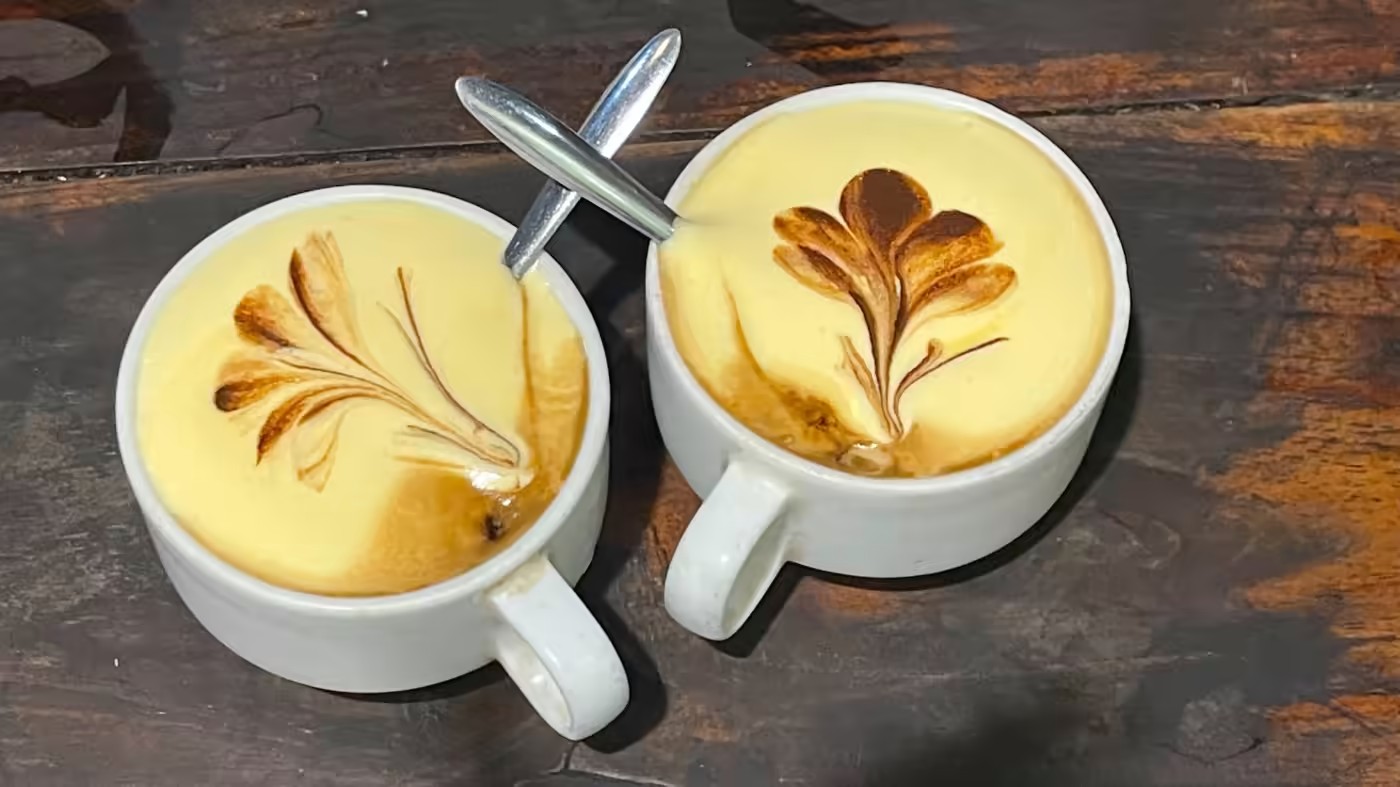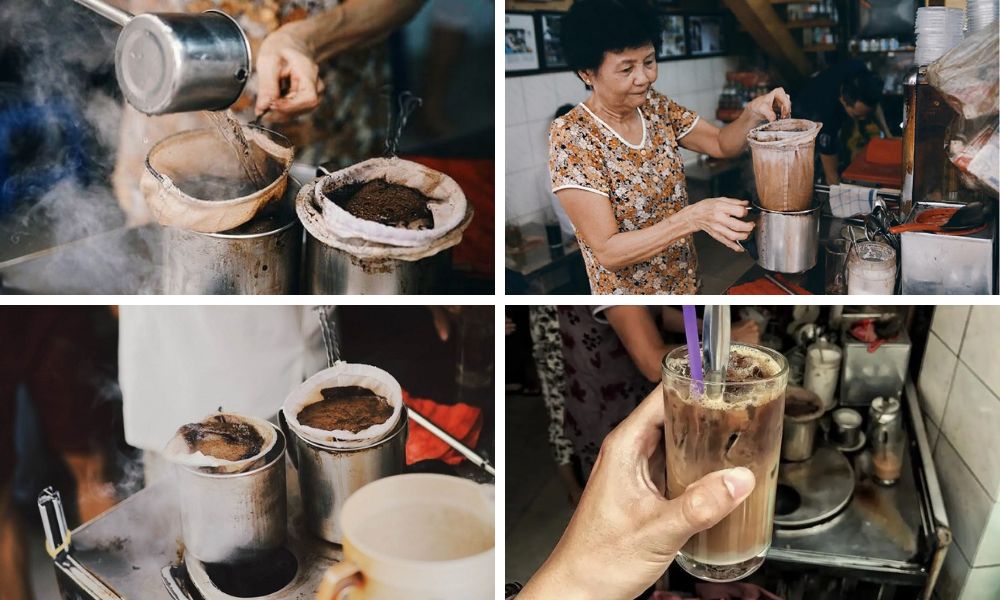The first touch that the Vietnamese had with coffee took place thanks to the French, especially in southern. Progressively, it became popular throughout the country.
The first touch that the Vietnamese had with coffee took place thanks to the French, especially in southern Vietnam. Progressively, it came closer to everyone’s reach and became popular throughout the country.
1. History of Vietnamese coffee
The French brought coffee plants to Vietnam in 1857. In early 1900, coffee was grown in some northern provinces such as Tuyen Quang, Lang Son and Ninh Binh. Arabica coffee is also grown in central regions, such as Nghe An and Ha Tinh provinces. Although Arabica coffee first appeared in Vietnam, there were many Excelsa coffee gardens planted during this period. It took a long time before the French began to cultivate coffee gardens in today’s Central Highlands.
Initially, people planted Arabica coffee in the Central Highlands. During the process of growth and development, Arabica coffee plants were too severe to degenerate by rust. In the end, thưy decided to replace Arabica Coffee with Robusta Coffee and Excelsa Coffee in Central Highlands.
At that time, people usually made coffee with a France-origin filter. Making French coffee was not easy since it needed tools from France. Consequently, the Vietnamese tried to make coffee in their own way. They modified the traditional methods, making it much simpler. Simultaneously, the Vietnamese learned the method of making coffee from the Chinese, which was called coffee “vot”. Moreover, they also invented the Vietnamese filter to make this new drink affordable for everyone and easy to prepare at home. It remains unknown until today when the Vietnamese invented their own filter, but surely, its presence has radically changed the methods of making and consumption of coffee. Below, we will talk about the different ways of preparing “vot” coffee and Vietnamese filter coffee

2. The popular coffee varieties in Vietnam
2.1. Robusta
Robusta Coffee in the Central Highlands accounts for 80% of the total coffee export output of Vietnam. Dak Lak province becomes the largest coffee area in Vietnam and Dak Lak’s coffee production accounts for nearly half of the country’s total coffee output. Dak Lak coffee is famous for quantity, not quality. And later split into Dak Nong, the area was narrowed but still maintained the leading position in Robusta production.
In the Southeast, in provinces such as Binh Duong, Binh Phuoc, Dong Nai also contribute a large quantity of Robusta coffee, but the quality of the flavor is somewhat inferior to that of Robusta coffee in the Central Highlands.
Robusta coffee is the main ingredient used in Vietnamese brewed coffee, characterized by a bitter taste, and 40% higher caffeine content than Arabica.
2.2. Arabica
Coffee strains belonging to the Arabica line that are especially delicious in Vietnam include Bourbon, Typica, Mocha (moka). But all three strains are difficult to grow because of low yield, susceptible to pests and diseases, so they are gradually removed from the coffee fields and gradually replaced by the Catimor strain - which was developed in Portugal in 1959, is a hybrid of two varieties Caturra and Timor (Timor is a cross between robusta lines with arabica). It is easy to grow, has high yields and is resistant to pests and diseases.
Currently, for Arabica in Vietnam, Catimor is widely grown in most of the major coffee material regions across the country, namely Lam Dong, Dak Lak, Dak Nong, Quang Tri, Nghe An, Son La. Thirty years ago, the “Moka” strain was grown in Cau Dat, Da Lat, this coffee is especially delicious and famous.
In each region, arabica coffee produces a different flavor: Arabica coffee grown in Da Lat gives a sweet taste and aroma of fruits. Arabica coffee grown in Dien Bien, Son La has a sweet taste and aroma of herbs. In the two provinces of Nghe An and Quang Tri, arabica coffee produces an acrid, salty aroma.
2.3 Excelsa, Liberia
Liberia or Excelsa coffee has a tree trunk 2m -5m high. Stems, leaves and fruits are all big, different from arabica and robusta coffees. Plants are drought tolerant, less need for watering, but poor yield, not high quality (sour taste), so it is not popular. In Vietnam, Excelsa coffee is grown mainly in provinces such as Nghe An, Gia Lai, and Kon Tum. Liberia coffee beans are often mixed with other coffee beans when roasted to create flavor. Excelsa coffee is often suitable for European tastes, instant coffees in Europe often have a high proportion of excelsa coffee.

3. Ways to prepare coffee in Vietnam
The typical Vietnamese coffee style is coffee made with a filter. Filter-made coffee is a French creation, but when coming to Vietnam, this way of making coffee has become a symbolic image of the local coffee culture, even more appreciated than French Press coffee for taste and sophistication. Coffee beans are usually ground, compressed into a filter and the boiling water is poured over it to be filtered into a glass, or cup, at the bottom of the filter.
3.1 Egg Coffee
Egg coffee was invented in the early 20th century by Nguyen Van Giang, a bartender of the Metropole Hotel in Hanoi. As Nguyen Van Hoa (the son of Mr. Giang) used to say, at the time, only Frech and rich people consumed cappuccino coffee because milk was scarce and expensive. As a result, the consumption of this drink was not suitable for everyone.
From the desire to be able to bring coffee to more people, Mr. Nguyen intended to find a less expensive ingredient. At the same time, he created a creamy layer of milk, which immediately bring him the thought of making it by egg. It was the best choice because the egg is popular in every Vietnamese family. It results in the invention of the new version of coffee, knowns as “the Vietnamese cappuccino” or coffee with egg. Immediately, this invention leads to the establishment of “Café Giang”, the first egg coffee shop in Hanoi.
Egg coffee is made from 2 main ingredients: egg and coffee. This coffee is a combination of black coffee and beaten eggs. The maker broke the egg and mix the yolk with sugar and then beat them by the electric mixer. In the past, people used a kind of wooden egg-beater. The process results in a foamy mixture: the zabaglione cream. The black coffee is slowly poured into a cup that already contains the egg mixture. Then the egg layer will float above the coffee. The secret lies in making the balance of the quantity and taste between.

There are two ways to do it:
-
Break a raw egg into a cup of hot coffee, add sugar, then stir well with or without milk;
-
Egg yolks are whipped into cream, with a small amount of black coffee underneath.
When serving coffee, the coffee cup is placed in a bowl with hot water. The purpose is to maintain the coffee temperature, preventing the coffee from cooling down, creating a bad smell from the egg. You can observe the process of making the egg coffee in a detailed manner following the images cut from the video produced by the program “Mon ngon moi ngay” (translated “every day a good dish”), uploaded on YouTube.
3.2 Filter coffee
The invention of the Vietnamese filter coffee maker is still a matter to be discovered. It is not yet possible to find in any historical document news on the birth and the inventor of Vietnamese filter coffee. Probably, the French filter inspired the Vietnamese to create this kind of filter. Vietnamese modified and simplified to make it suitable for the domestic use of all social classes.
Making coffee with the filter is not difficult at all but it is a slow ritual. In this process, the water slowly filters from the coffee and goes down into the glass. The operation takes about four or five minutes. The making of filter coffee somewhat recalls Neapolitan coffee. The steps of making Vietnamese filter coffee follow the description on the website of Trung Nguyen, a Vietnamese producer, and exporter of coffee.
People can enjoy filtered coffee in many ways, but Vietnamese prefer coffee with condensed milk and egg coffee. Coffee with condensed milk is considered a Vietnamese version of cappuccino without foam. Vietnamese use condensed milk because when the coffee arrived in Vietnam during the war, fresh milk was not always available and storable. From that time, the habit of using condensed milk has been widespread throughout the country.

Filter coffee with the addition of condensed milk in northern coffee shops is called “nau” (brown, to indicate the color of the coffee after its combination with milk). Whereas, in the south, it is called “bac xiu” (bac means white, xiu means small). “Bac xiu” is mixed by adding a large quantity of milk in a small quantity of coffee. Hence, the color of the coffee is a kind of very light brown. You can also drink it with some ice cubes.
- Hot black coffee
Put ground coffee in the coffee filter, lightly compress the coffee powder, and then put in hot water no more than 95 degrees to not burn the coffee powder. Inspired coffee leaking from under the filter. With or without adding sugar as your favor. The filter is usually made of aluminum, but nowadays, the aluminum filter is gradually replaced by the inox filter.
- Hot milk coffee
At the bottom of the cup is available condensed milk (more or less optional), after hot coffee falls from the filter, stirring them together. As a habit, hot coffee and hot coffee with milk are usually drunk early in the morning during/before breakfast. Many people drink hot coffee/hot milk coffee without breakfast.
- Iced Coffee
The way of making it is the same as hot black coffee, but the coffee is thickened (more coffee powder), then added ice, some people like to give up sugar, some people don’t, depending on “personal taste”.
- Iced Milk Coffee
The brewing method is the same as hot milk coffee, but mix very thickly (more coffee, lots of milk), then add ice, stir well.
- Bac xiu
In Chinese “白 小” means “white and little”, derived from the coffee drinking habits of the Cantonese Vietnamese, popular only in the South: the same recipe of milk coffee milk, but more milk, and less coffee, suitable for women; condensed condensed milk can be replaced with fresh milk. There are two types: hot and icy.

3.3 Coffee “vot”- racket coffee
Over time, coffee preparation methods have evolved, varying from country to country. Nevertheless, a very ancient method of preparation still exists, which consists of extracting the coffee after immersing its powder in the boiling water. It is called “vot” coffee in Vietnam. Originally, the “vot” coffee arrived in Vietnam thanks to the Chinese, who took refuge in the 18th century after the fall of the Ming dynasty. The Chinese were the first to open the southern Vietnamese coffee shops.
Today there are only a few coffee shops that serve “vot” coffee, including the “Cheo leo” coffee shop. Established in 1938, this is one of the oldest cafés, often frequented by artists of that era. People make “vot” coffee in a large container, using a fabric filter to prevent the coffee powder from falling together with the water. Nonetheless, this method is no longer used in Vietnam. Fortunately, a few traditional bars still keep this method of making coffee. People attend these bars not only to taste the coffee prepared in a lost method but also to remind of a distant past.
The tools to make racket coffee are very simple: a container and a fabric filter. This might be the simplest and oldest method in coffee making: boiling water is poured into the cloth filter that contains the coffee powder. Leaving it melting for a desired time, the coffee comes out and ends up in an earthenware pot. Ready coffee is left on the stove over low heat. However, do not leave the coffee in the filter for too long, which could alter its taste (it increases acidity and bitterness). It should take around 3-4 minutes to make racket coffee. The obtained coffee has a good aroma.

4. Modern coffee chains “Made in Vietnam”
Besides the old coffee shops only in one location, Vietnam also owns modern coffee chains that were established in the 1990s. They are formidable competitors of Starbuck or Twitter Bean.
4.1 Trung Nguyen Legend
Trung Nguyen Legend coffee brand is very famous not only in Vietnam but world wide. If you enjoy an energy coffee made from the best quality coffee beans, you can’t miss Trung Nguyen.
4.2 Highlands Coffee
Highlands Coffee was founded by David Thai - an overseas Vietnamese since 2002. Highlands Coffee has since expanded its chain in the most expensive locations in big cities. Most of Highlands Coffee’s locations are located under the buildings, next to the commercial center, with two fronts right on the busy main street. Highlands Coffee’s customers are quite diverse with office people, business people, families with good income.
4.3 The Coffee House
The Coffee House was founded by Nguyen Hai Ninh - a young founder who also owned another famous chain cafe brand, Urban Station. The Coffee House takes place in a modern, luxurious, open space and beautiful view, for young people who are passionate about working (workaholic) & creative.
4.4 Cộng Cà Phê
Cong Cafe was born in 2007, with its origins as a small café on Trieu Viet Vuong street in Hanoi, which is famous for its small sidewalk cafes. The word “Cong” makes us think of “Communist” - the form of the Vietnamese state at that time. Young people come to Cong Coffee not only to drink coffee but also to experience the Hanoi old style space in the 80s and 90s. “Coffee mixed with coconut milk” is the most popular cup in Cong Coffee.